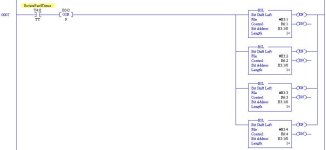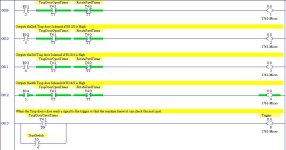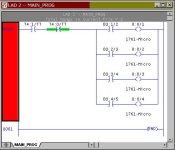gbradley
Lifetime Supporting Member
I built a part sorting machine that uses a rotary table.
The first station measures the part and then based on the value it is dumped in one of four bins.
I used the Bit Shift to keep track of the Bins.
The ladder has basically three parts:
1. detect an input and latch a register bit.
2. bit shift all register bits one place.
3. output to the appropriate Solenoids based on the shifted value.
This is working well, but I was hoping for some criticism on my method.
Thanks George Bradley

The first station measures the part and then based on the value it is dumped in one of four bins.
I used the Bit Shift to keep track of the Bins.
The ladder has basically three parts:
1. detect an input and latch a register bit.
2. bit shift all register bits one place.
3. output to the appropriate Solenoids based on the shifted value.
This is working well, but I was hoping for some criticism on my method.
Thanks George Bradley






